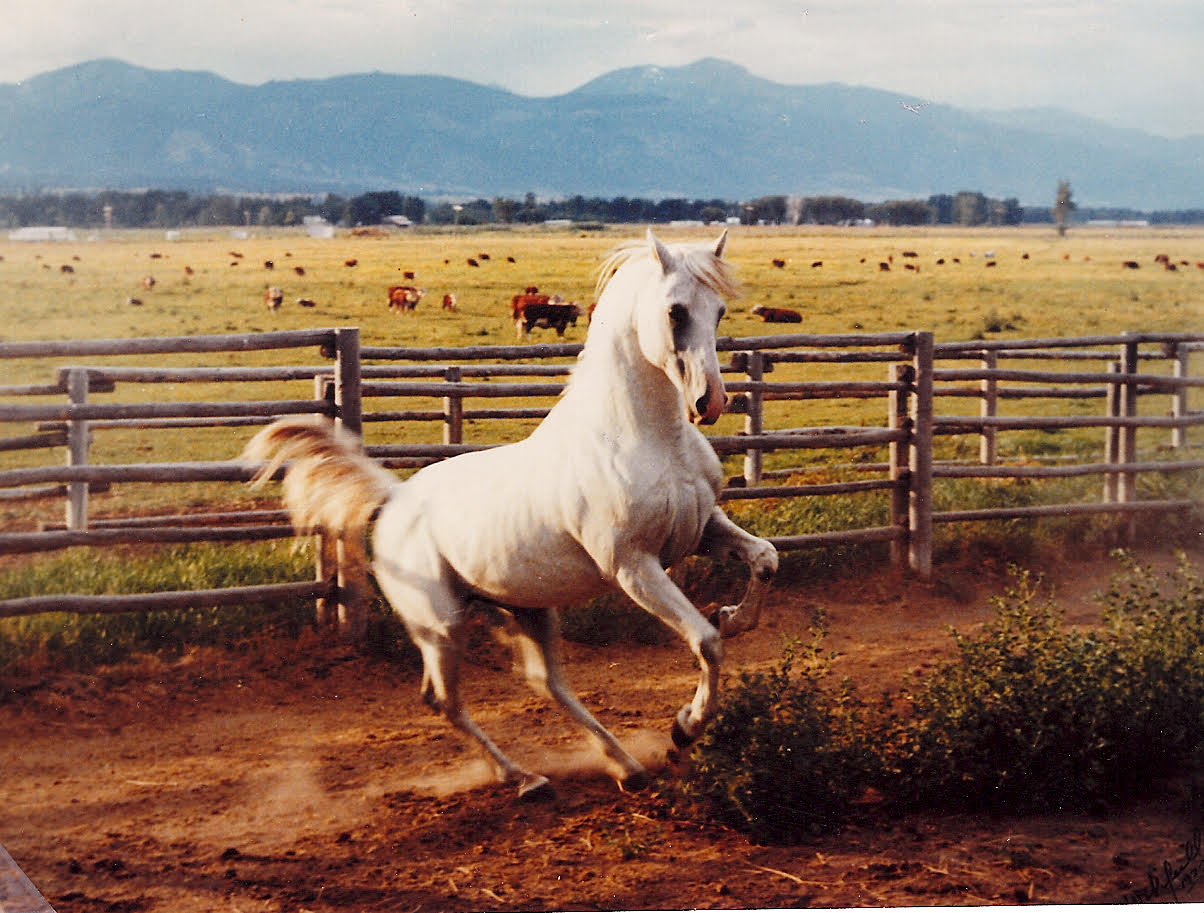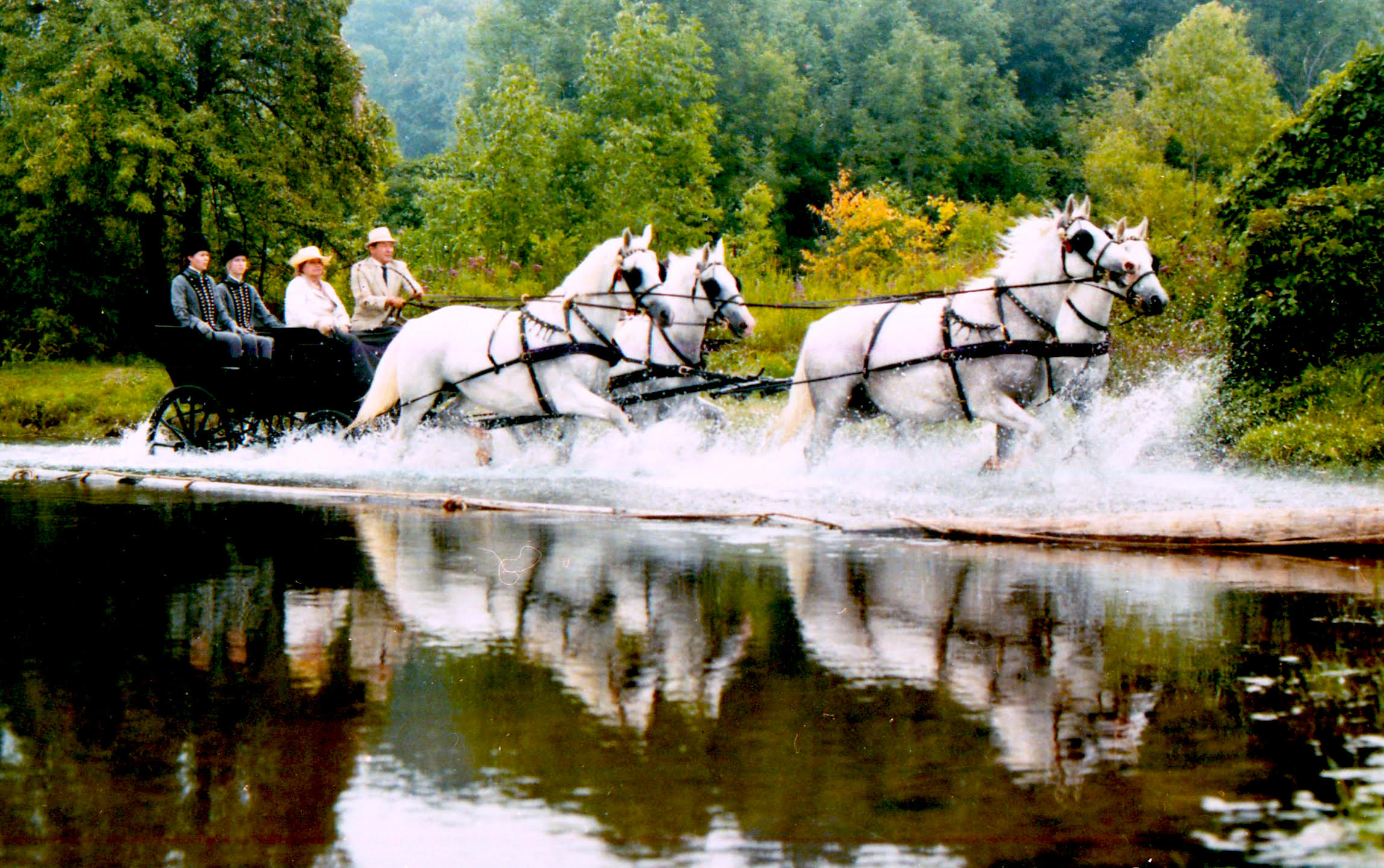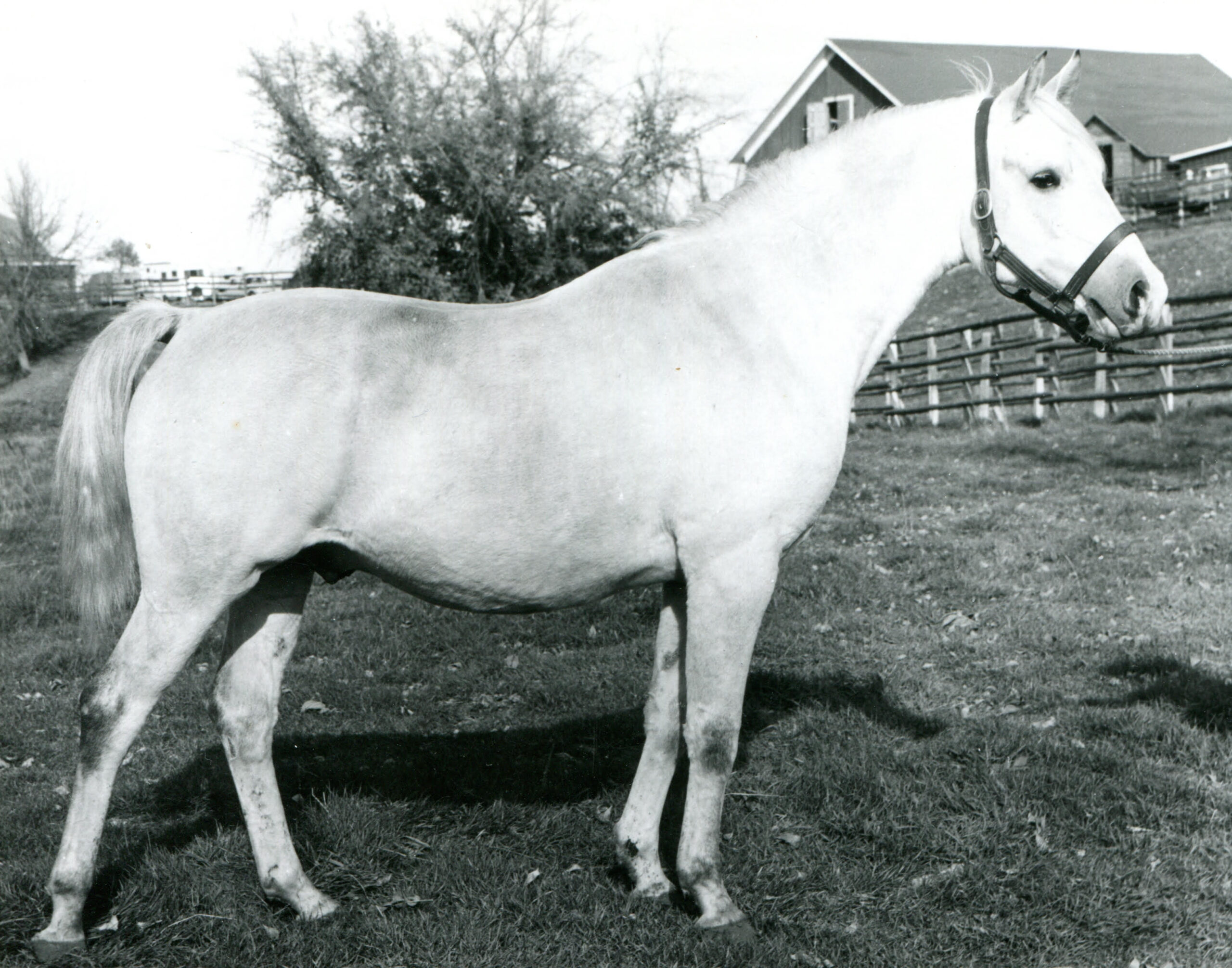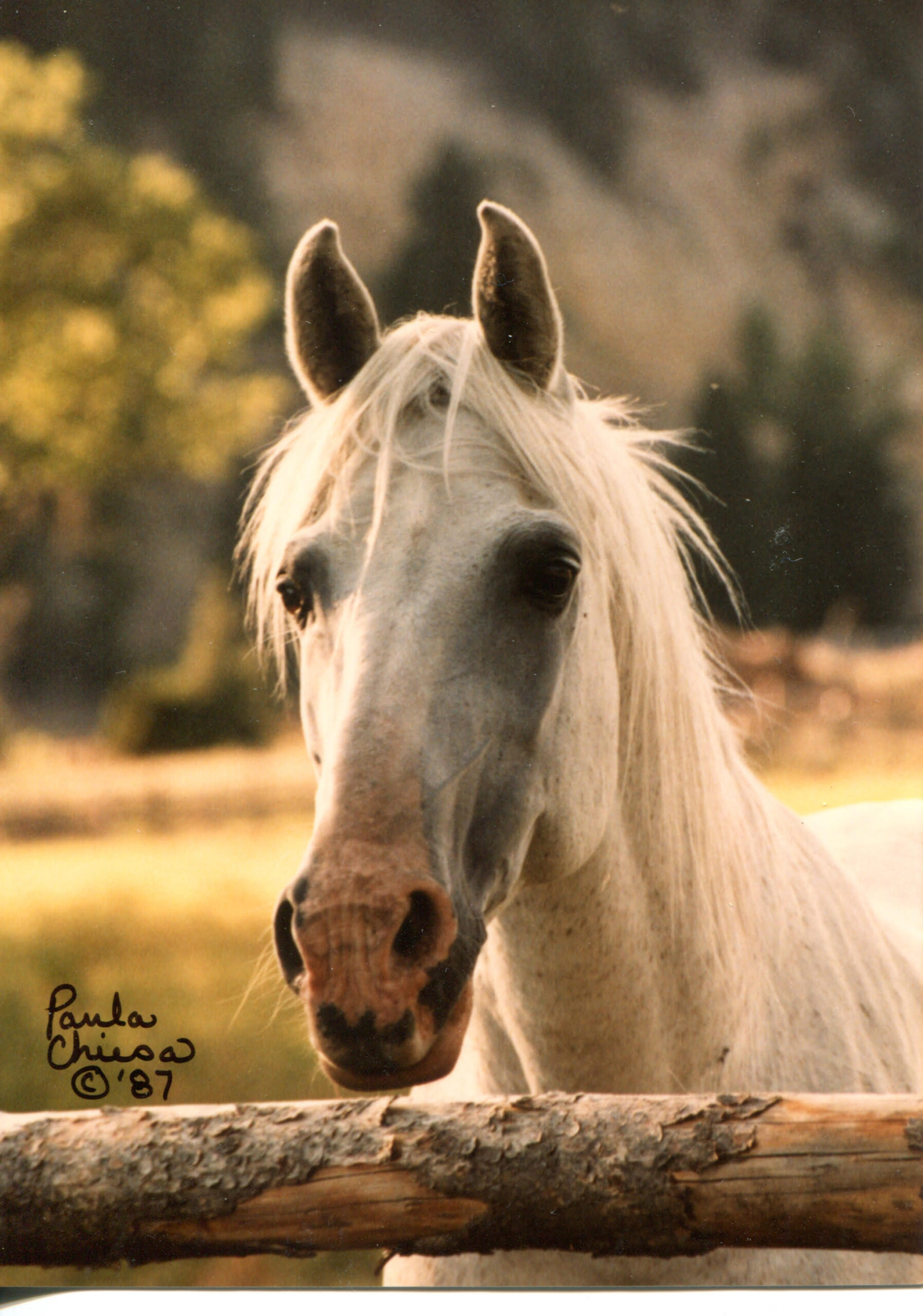
Bravo playing in his pasture on the Countesses’ Bitterroot Stock Farm
The Story of “Hungarian Bravo”
by Adele Furby
The World Arabian Horse Organization recognizes three separate breeds of Arabian Horse. In America, while most Arabian lovers are acquainted with two of these – the Purebred Arabian and the Half-Arabian, the large majority of them are unfamiliar with the third breed ~ the Shagya Arabian. That is probably the reason why HUNGARIAN BRAVO, my 28-year-old Shagya Arabian stallion, lived the first 24 years of his life in relative obscurity, on the ranch of a Hungarian Countess, where he was known only as “the Polish Arab.” Through a serendipitous set of circumstances, I was to meet BRAVO, and as you will read in the following little story, this meeting led me through some fantastic adventures.
I have been an Arabian owner and breeder since 1973, but decided about 1980 to take it on as a full-time business. At that time I added to my basic Hunt-seat, Endurance and Western riding background by studying genetics, horse management and Western training at Montana State University in Bozeman. Following that, a five-month stint as a working student in dressage with Major Hector Carmona in New Jersey kindled a serious interest in dressage, and further experience working in California at an eventing stable confirmed in me the desire to specialize in breeding Arabian horses for dressage and combined training.
The more I learned about sport horse qualifications and the various Arabian bloodlines, the more it became evident to me that I was facing a dilemma – most purebred Arabians are not competitive against the other sport horse breeds in open showing. This is not surprising, as the Bedouin had a different breeding goal. But, like any true Arabian lover, I was hooked on the natural impulsion, lightness, sensitivity, intelligence, beauty and soundness of the Arabian horse. I did focus in on certain Arabian bloodlines that I had found which had some of the best sport horse qualities. In particular I was impressed with the Pritzlaff Egyptian lines, particularly through *Rashad Ibn Nazeeer and *Bint ,Moniet el Nefous, and the old desert-bred lines like the Davenports and *Mirage, the Babsons and some of the Crabbet and Kellog lines.
However, since no one in America had been breeding purebred Arabians specifically for sport horse qualities for more than a few generations, it seemed a difficult task to develop genetically predictable Arabian sport horses within my own lifetime. I considered Half-Arabian breeding, using breeds such as the Lipizzaner, Andalusian, or Lusitano in order to try to increase size and power, while still maintaining Arabian type. I heard the same advice from many people – sometimes the resulting hybrid is just great, the best combination of both breeds, but sometimes you can be disappointed, as the resulting offspring can inherit the least desirable combination of characteristics.
About this time, spring of ’83, I saw an article entitled “Shagyas, the Other Arabians,” written by a German Arabian expert, it explained that the Shagya Arabian is a nearly two-hundred-year-old breed developed in Austria and Hungary as an Arabian-bred horse suitable for “military” (three-day event) use and driving. The article stated. “The ideal Shagya Arabian is a riding horse of distinct Arabian type, but one that stands 16 hands or more (definitely not under 15 hands) and has plenty of bone.” WOW! The more I read and looked at the accompanying pictures, I couldn’t believe my eyes! Here was a breed that had been selectively (through performance testing) line bred for over 150 years, for exactly the characteristics I was looking for! This was genetic predictability! The article also explained that many countries had no Shagya registries, and so many Shagya owners in these countries simply didn’t know what they had. That was why I had never heard of them. Needless to say, I started my search for Shagyas right away.
Unfortunately, my first attempts to find Shagyas weren’t fruitful. Several letters to Europe elicited mainly the fact that I could send to Germany for the newly published German Studbook for Purebred Shagyas. But no one seemed to know of the whereabouts of any Shagyas in America. I sent away for the German studbooks and kept on searching.
A number of months went by, and there were still no Shagyas on the horizon. Then I had one of those bits of luck, right when I least expected. It was at a meeting of our local dressage and jumping club, and while making conversation with a new acquaintance, I asked her what type of horse she had. “I have a Hungarian,” she replied. “What’s that I asked. “I’ve heard of Hungarians but I have no idea what they are.” “Well,” she explained, “the Hungarian Warmblood is a cross between Shagya Arabian, Thoroughbred… and, of course, at that point I got very excited, because I had vaguely heard about a Hungarian Countess who raised Hungarian horses in a neighboring valley. Could this mean that I might find Shagyas right here in Montana, only a few hours drive from my own ranch?
I obtained the telephone number of Bud Ruark, stud farm manager for Countess Margit Sigray Bessenyey’s Bitterroot Stock Farm, and explained to him that I was looking for Shagyas. He replied that he didn’t know anything about the pedigrees of the horses but that if I visited the Farm I could examine the studbooks myself. The Bitterroot Stock Farm is a 22,000 acre ranch which Countess Bessenyey inherited from her grandfather, known as the “Copper King of Montana.” The story of Countess Bessenyey’s life could fill several exciting books, but here is a very brief summary. Countess Margit Sigray grew up in Hungary on her Hungarian father’s estate; her mother was the. American-born daughter of Marcus Daly. She fled Hungary during World War II, came to America, and inherited the Anaconda Copper Company (now ARCO Oil) and several estates, one of which was her grandfather’s Bitterroot Stock Farm, which had been Daly’s race-horse farm. Although all of the family horses were lost in Hungary, soon after the Countess’ arrival in America, she was able to purchase nine horses from the U.S. Army Remount. These were horses of several Hungarian breeds which had been captured by General Patton and the U.S. Army. Most Americans know the story of this capture from the Disney movie “The Miracle of the White Stallions,” which tells of the Lipizzaner horses which were rescued. Witez II, the Polish Arabian, was another famous representative of the Patton imports. With her nine foundation animals the Countess began breeding Hungarian Warmbloods, and established the Hungarian Horse Association in America.
 Countess Bessenyey competing in four-in-hand combined driving with her team of Hungarian Bravo/Percheron team.
Countess Bessenyey competing in four-in-hand combined driving with her team of Hungarian Bravo/Percheron team.
When I arrived at the Bitterroot Stock Farm in the spring of 1984 there were 200 Hungarian Horses at the ranch. The pastures were big and beautiful, with horses everywhere! The Countess herself was at her Maryland estate, so I did not get to meet her. Bud got out the studbooks and my friend Donna Hyora and I began pouring over them. We didn’t know much about Shagya pedigrees, but the Countess’ carefully maintained stud books eased the task – all of the pedigrees were written in three colors – red for thoroughbred, black for warmblood, and green for Arabian blood. It only took us a few hours to determine that, of the original horses purchased from the U.S, Army Remount, three had been Shagya Arabians – all mares bred in Babolna, Hungary, birthplace of the Shagya Arabian breed. The mares, however, had usually been bred to warmblood stallions, and, of the 200 horses at the ranch, only one individual had a pedigree that was all of Arabian and Shagya Arabian blood, and that was BRAVO. BRAVO’s dam, named 52 GAZAL II, was born in 1937 in Babolna, Hungary, and his sire was PILOT, PASB, by TRYFOLIS and out of an OFIR daughter. Donna and I told Bud that BRAVO was the horse that we’d like to see, and so we drove out to see what he looked like.
When I first saw BRAVO he was 24 years old. He looked so much like the Shagyas I had seen in pictures – he definitely did not look like a purebred Arabian. Although he had excellent Arabian type, he was overall, too big to be a purebred. His bones were much more substantial, his neck was long and well set on, his hindquarters appeared very powerful, and I had never seen such correct legs on an Arabian-bred horse. BRAVO had never been broke to saddle, but had been handled only by ranch employees for breeding. At first he was afraid to come close to us, but soon he figured out that we were there on a friendly mission and he allowed me to approach him. He put his nose against my chest and the mutual trust was instant. I was transported into the clouds above, and my Shagya adventure had really begun!
Meeting Hungarian Bravo Slider
Adele meets Bravo, at age 24, for the first time
I had only one Arabian mare still open that spring (it was May when I found BRAVO), and so I brought her over to BRAVO. Of course BRAVO was not for sale, but I told Bud to let me know if he ever was. That fall the Countess Bessenyey died suddenly and unexpectedly, before I was ever able to meet her. I wrote a note to Bud and told him that if they were looking for a home for BRAVO to please let me know. Bud called right away, and said, “Come and get him right now. In the Countess’ will she stipulated that 22 of her favorite horses were to be destroyed upon her death so as to not fall into the wrong hands, and BRAVO is on the list! But I have 30 days as her legal agent before the matter is out of my hands, so you must get him immediately.” I wasted no time. BRAVO came home to our ranch.
Soon thereafter, the German Shagya Arabian studbooks arrived. This was my opportunity to begin to study the pedigrees of the Shagyas. The Shagya studbook is a fantastic reference work, consisting of photos and five-generation pedigrees for about 800 Shagyas, along with introductory articles (with English translations) on the major Shagya sire lines by Dr. Gramatski. I compared the pedigrees in the studbook with BRAVO’s and I couldn’t believe my luck! BRAVO’s dam was a daughter of GAZAL II, and the stallion on the cover of the studbooks, considered the “Shagya Stallion of the Century” in Europe, was a son of GAZAL II – named GAZAL VII. So, not only was BRAVO a beautiful individual, he had a pedigree to match!
The spring of 1985 I started searching the country for purebred Arabian mares suitable for breeding to BRAVO. I wanted to import some mares from Europe also, but was scared to death that BRAVO would die before I could get the mares to America. I bought or leased a total of eight mares that I felt would have the best potential for breeding with BRAVO, and got them all in foal. In May, BRAVO’s first Shagya foal was born out of the mare that I had taken over to the Stock farm the previous year. I had never seen anything like him. He was so much bigger than any purebred foal I had ever seen, and the conformation was so correct. Naturally, I named him BRAVISSIMO.
Meanwhile, I wrote to Dr. Gramatski, then President of the Purebred Shagya Society International, including snapshots of BRAVO and his pedigree. That is when the doors started to open for me in Europe. Dr. Gramatski wrote back. “In his phenotype BRAVO is all in the line of GAZAL, and we would be very pleased if BRAVO could become the foundation for Shagya Arabian breeding in America.”

Hungarian Bravo’s official Hungarian Horse Studbook photo—he was 8 years old
A short time later he wrote again, inviting me to come to the International Shagya Arabian Show in Verden, West Germany. It was rather short notice, but it represented another golden opportunity, as by then I had determined that I needed to import some purebred Shagyas from Europe in order to embark upon a program of purebred Shagya breeding.
The International Shagya Arabian Show was a great opportunity to see over 200 Shagyas from all over Europe all in one place. There were two full days of non-stop Halter, Dressage, and Jumping classes. There were lots of breeders to meet and horses to look at. Following the show I traveled around Germany, Switzerland, and Denmark and selected three Shagya Arabian mares, and two young stallions to import to America. These, along with the purebred Arabian mares that I had selected in America became the foundation for my purebred Shagya breeding program.
The imported Shagya Arabians arrived in Montana during the spring of 1987 after their long trip and expensive quarantine. Meanwhile, BRAVO himself continued to thrive, breeding 10 or 15 mares each season. This year, at age 28, I think he looks better than I have ever seen him. And his offspring, the first of which is now coming three years-old are exceeding my expectations. Not only do they have size, correctness, excellent type and movement, but they have the best dispositions I have ever worked with. It’s getting to be a joke around here in the fall when the foals are Halter broke and tied up to something solid so they will learn to stand tied. The BRAVO babies are all so smart they won’t even pull back. I’m looking forward to some easy training in the future, and it’s all thanks to HUNGARIAN BRAVO and the many generations of Hungarians who developed this noble breed.
This article appeared in the April 1988 edition of Arabian Visions.
Read here about *Pilot, the Sire of Hungarian Bravo
Hungarian Bravo Pedigree
Shagya-Arabians Blue
Purebred Arabians Green



